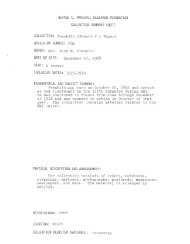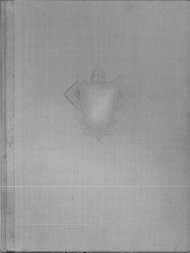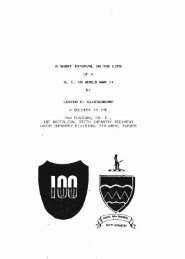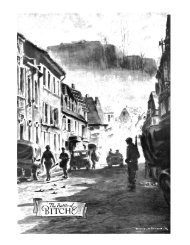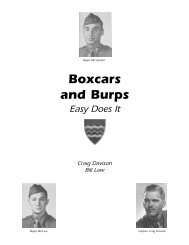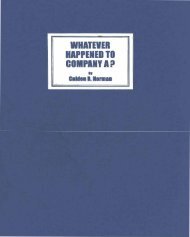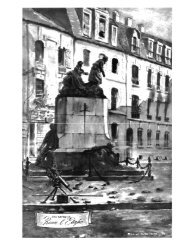Most Underrated General of World War II - The George C. Marshall ...
Most Underrated General of World War II - The George C. Marshall ...
Most Underrated General of World War II - The George C. Marshall ...
You also want an ePaper? Increase the reach of your titles
YUMPU automatically turns print PDFs into web optimized ePapers that Google loves.
In an army as small as the miniature US Army between the wars, (190,000 men in 1939), Patch managed to keep his<br />
hand in training combat troops as well as honing his skills as a coach and mentor <strong>of</strong> young men.<br />
Between the wars, Patch spent 11 years, parsed out over three separate tours, as Pr<strong>of</strong>essor <strong>of</strong> Military Science and<br />
Tactics at Staunton Military Academy, a private secondary school in western Virginia, near the Virginia Military Institute<br />
(VMI). Here, while Patch honed his skills as a trainer and groomer <strong>of</strong> young men, he met and befriended Withers A.<br />
Burress, the commandant at the VMI, who later commanded the 100th Infantry Division under Patch in Europe in WW<strong>II</strong>.<br />
One <strong>of</strong> his last assignments before the US entered WW<strong>II</strong> was as commander <strong>of</strong> the 47th Infantry Regiment <strong>of</strong> the 9th<br />
Infantry Division at Fort Bragg, North Carolina. This assignment was a particularly fortuitous one, as the 9th’s<br />
commanding general was Jacob Devers, a man who would later figure very prominently in Patch’s WW<strong>II</strong> service<br />
Patch in the Pacific<br />
Barely a month after the Japanese sneak attack at Pearl Harbor, Patch was promoted to major general and assigned to<br />
command Task Force 6814, a quickly tossed-together ad hoc assembly <strong>of</strong> roughly divisional size built around two<br />
National Guard infantry regiments. <strong>The</strong> task force was charged with the mission <strong>of</strong> defending the French colony <strong>of</strong> New<br />
Caledonia from what appeared to be imminent Japanese attack; with things going quite badly for the American Regular<br />
Army forces in the Philippines at the time, there was considerable question about the ability <strong>of</strong> US forces to defeat the<br />
Japanese on the ground. So Patch was literally the “man in the arena,” the champion personally selected by Army Chief <strong>of</strong><br />
Staff <strong>George</strong> C. <strong>Marshall</strong> to go to the southwest Pacific with whatever the Army could scrape together and stand between<br />
the rapidly-advancing Japanese and the frantically-preparing Australians.<br />
En route, Patch was again stricken with pneumonia, but overcame it again to arrive in New Caledonia in early March<br />
1942. Although this was literally his first acquaintance with his new command, he busily set about organizing and training<br />
them for the formidable task at hand: defending the 1,250-mile-long island.<br />
With New Caledonia secure, Patch’s next mission as commanding general <strong>of</strong> the Americal Division (this name was<br />
suggested by PFC David Fonseca, combining “American” with “New Caledonia”) was to relieve the 1st Marine Division<br />
and, on orders from Admiral Halsey, “eliminate all Japanese forces on Guadalcanal.” Landing in August 1942, Marine<br />
Major <strong>General</strong> Archie Vandegrift’s division struck the first American <strong>of</strong>fensive blow on the ground against the Japanese<br />
who, up until that time, had been seemingly invincible in their defeats <strong>of</strong> the Americans in the Philippines, the British at<br />
Singapore, and the Dutch in the East Indies. Locked in desperate fighting in the pesthole that was Guadalcanal, the<br />
Marines and their US Navy supporting elements tenaciously fought a see-saw action that held on to the crucial perimeter<br />
around the key airstrip at Henderson Field, but were unable to make decisive headway against constantly-reinforced,<br />
aggressive Japanese forces.<br />
On 9 December Patch and the Americal Division <strong>of</strong>ficially relieved Vandegrift and the 1st Marine Division. In early<br />
January, as the 25th Infantry Division and 2nd Marine Division completed their deployment to Guadalcanal, Patch was<br />
promoted to command <strong>of</strong> the newly-created XIV Corps, the headquarters which controlled them all.<br />
Patch launched the corps’ attack on 10 January 1943, and in almost exactly a month <strong>of</strong> vicious jungle fighting, XIV<br />
Corps methodically and effectively cleared the Japanese from Guadalcanal. It was an immensely important victory<br />
because it was pro<strong>of</strong> that American ground forces could not only stave <strong>of</strong>f defeat—as the 1st Marine Division had in the<br />
first four months <strong>of</strong> the Guadalcanal operation—but decisively clear the Japanese <strong>of</strong>f a large island.<br />
Typically, few people today associate Patch’s name with Guadalcanal. Marine Major <strong>General</strong> Archie Vandegrift, who<br />
was awarded the Medal <strong>of</strong> Honor and later went on to become the Commandant <strong>of</strong> the Marine Corps, is the general<br />
<strong>of</strong>ficer whose name is usually associated with this battle. Partially, this is undoubtedly due to the Marines’ legendary<br />
public relations talents, and partially, it is a function <strong>of</strong> timing. Public awareness <strong>of</strong> the exceptionally important and hardwon<br />
victory on Guadalcanal, skillfully engineered by Patch with many <strong>of</strong> the soldiers he personally trained, was largely<br />
lost in the hoopla surrounding his predecessor’s publicity and the other major, positive developments in the course <strong>of</strong> the<br />
war. Although it was all fine with the self-effacing, quietly-pr<strong>of</strong>essional Patch, it was far from the last time that this sort <strong>of</strong><br />
phenomenon would obscure his magnificent achievements.<br />
After Guadalcanal, <strong>Marshall</strong> recalled Patch to command IV Corps at Fort Lewis. <strong>Marshall</strong> had been apprised,<br />
accurately, that the campaigns in the southwest Pacific had severely degraded Patch’s health, and, remembering his nearrun<br />
bout with pneumonia en route to New Caledonia, the Chief <strong>of</strong> Staff brought him back to a more hospitable climate.<br />
During the period at Lewis, Patch built a staff, combining <strong>of</strong>ficers who had served with him in the southwest Pacific with<br />
many who had been already serving in IV Corps when Patch arrived. To a very great extent, this was the staff that Patch<br />
would take with him for the rest <strong>of</strong> the war, so they were a very cohesive and well-coordinated group indeed. Patton was<br />
not the only one to derive intense loyalty from his subordinate staffers.




